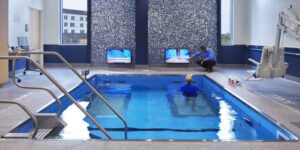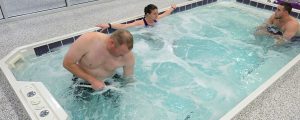Aquatic Therapy’s Impact on Recovery, Movement & Rest
We often notice trends as they relate to the industries we serve, including rehab, senior care, fitness, and athletic training. Lately we’ve seen a trend toward the discussion of movement vs. rest as the most beneficial for recovery.
What Is Recovery?
Many people still think recovery means sitting around on the couch until they’re no longer sore. While being still is a necessary ingredient of recovery, it’s certainly not the whole dish.
Recovery is everything that happens after one workout and before the next. Recovery includes sleep and nutrition, along with physical, mental, spiritual and emotional rejuvenation. When applied correctly, recovery is purposeful; it’s robust, focused and determined, even as it allows the body to heal with rest.
Blood flow to the muscle tissues is of major importance during the recovery process. The body’s blood cells send oxygen and muscle-building nutrients to muscle tissues, then remove waste products and carbon dioxide from the tissue; the more blood cells interacting with muscle tissue, the better! Therefore, active recovery—things that get you moving without tearing down your tissues—becomes the key to success. Finding a way to increase blood flow without exacerbating injury, swelling or soreness, is the sweet spot.
Does Active Recovery Decrease Injury?
Many injuries occur because the necessary time isn’t taken to fully recover. Many times, a young person will think little of an injury, while being more focused on developing a sport’s necessary skillset. Rest, recovery and their relationship to staying healthy is a distant thought. But as athletes progress through life, move through stages of athletic careers, or fight chronic pain, they can begin to understand how the body and its wellbeing must be actively safeguarded.
Active recovery allows for the necessary recovery, without a loss of activity or improvement.
How Can Aquatic Therapy Help Recovery?
The combination of hydrostatic pressure and active motion in the water can have impressive effects on the body’s ability to recover. A therapeutic option like walking or running, when done in water, not only increases blood flow, but decreases swelling and invigorates worn-out athletes. Athletes exit the therapy pool feeling refreshed and rested, yet having engaged in an effective workout.
Benefits of Aquatic Therapy in Active Recovery
Time and time again, HydroWorx pools have been used by PTs, OTs, athletic trainers, and other health care providers to offer the best recovery mechanisms available. Here are a few highlights of what can be gained from spending some time recovering on an underwater treadmill:
More Muscle Nourishment
By being submerged in water, body weight can be reduced by up to 90%, meaning an athlete weighing 200 lbs. in neck-deep water, bears only 20 lbs. With less weight to carry, there is minimal injury risk and undue stress while still circulating blood at a steady rate, providing muscles with the nutrients necessary to rebuild. Additionally, water increases kinesthetic awareness of body and promotes relaxation.
Less Impact
Regular land exercise—especially jogging—can jar the body. But under water, foot-striking forces are drastically reduced. Over the long term, there is also less burden on the body. Because of this, the underwater runner can endure longer runs without increasing risk of injury. Buoyancy is the catalyst for pain-free movement while blood flow continues to feed and clean muscle tissue.
More Strengthening
Water’s natural drag—or viscosity—provides constant resistance. By pushing against this force of water, muscles are strengthened, some of which are not used on land. When underwater treadmills are used in addition to land training, athletes find a rejuvenation in their legs, core and upper bodies.
Less Soreness
When in the water, due to hydrostatic pressure, circulation improves and swelling decreases. Thoracic pressure and the venous return process “supercharges” with the added pressure of the water on limbs and core. This pressure helps move the lactic acid through the body and as a result, muscle soreness decreases.
In a study from Texas A&M University, it was found that participants performing resistance training plus underwater treadmill training showed definite benefits over those who completed resistance training alone or resistance training plus land treadmill training. The group experienced reduced soreness, decreased blood pressure, inflammation and body fat, but also improved lean muscle mass and strength performance.
Contact HydroWorx Today
When athletes and their athletic trainers listen to their bodies, and use aquatic therapy along with other recovery modalities, they’ll be utilizing the best restorative methods available.
To learn more about how active recovery catalyzes regeneration, download our tip sheet>>




